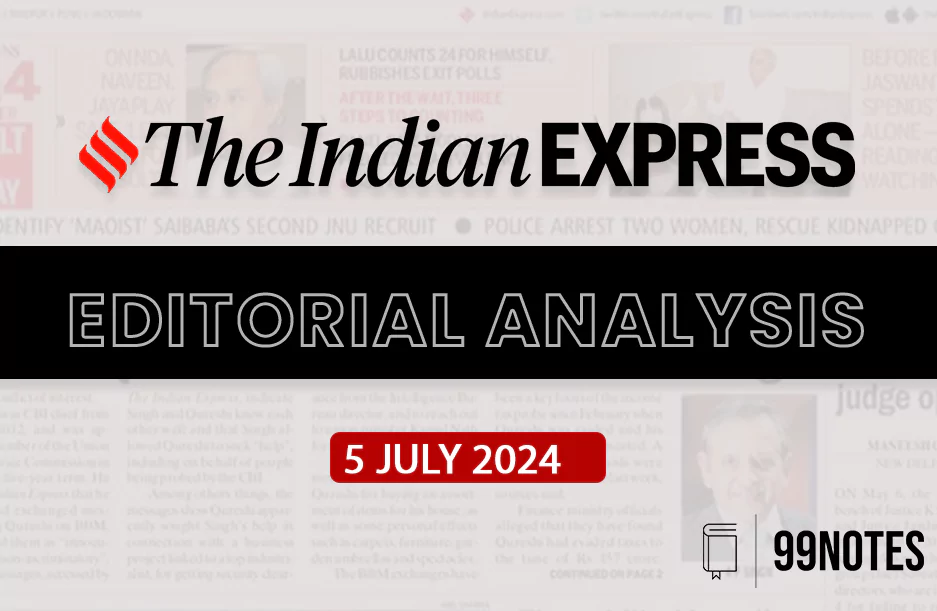5 July 2024 : Indian Express Editorial Analysis
1. Constitution at the centre
(Source: Indian Express; Section: The Editorial Page; Page: 10)
| Topic: GS2– Polity – Parliament |
| Context: |
|
Constitutional and Legal Dynamics
- The phrase “shall bear true faith and allegiance to the Constitution of India as established by law” used in the oath is intriguing because the Constitution itself determines the validity of laws passed by Parliament, not vice versa.
- While there were initial doubts, it is now universally accepted that constitutional amendments are subject to judicial review.
- This acceptance underscores the supreme authority of the Constitution in guiding the legal and legislative processes of the nation.
The Cynic’s Perspective
- Cynics and realists might argue that this newfound reverence for the Constitution is a strategic move to enhance democratic legitimacy rather than a genuine commitment to constitutional duties or principles.
- They may contend that this trend has minimal impact on adherence to Part IV-A (Fundamental Duties) or Part IV (Directive Principles of State Policy), or even on the rights of liberty and equality enshrined in Part III of the Constitution.
- However, it is essential to recognize that voters have embraced the concept of constitutionalism as a means to safeguard their freedoms against uncertain political futures.
The Role of the Judiciary
- The oath taken by Justices of the Supreme Court and High Courts highlights their commitment to performing their duties without fear or favor, thereby ensuring the independence of the judiciary.
- This independence is crucial for maintaining the rule of law and protecting the constitutional framework from internal and external threats.
- The judiciary’s role in interpreting the Constitution is not an overreach but a necessary function to uphold justice and prevent misuse of power.
Constitutional Renaissance
- The 45th Chief Justice of India, Dipak Misra, emphasized the need for constitutional functionaries to embrace a constitutional renaissance, understanding their responsibilities and adhering to constitutional principles.
- This renaissance is about renewing the practices of governance in line with constitutional values and ensuring that judicial interpretations remain faithful to the core principles of the law while allowing for reasoned departures in cases of manifest injustice.
The Kesavananda Bharati Case
- The landmark Kesavananda Bharati case established that constitutional powers are supreme within their domains but also limited and accountable. This case reinforced the idea that there are no sovereign powers, only supreme constitutional powers within set limits.
- The Basic Structure doctrine, which emerged from this case, protects the fundamental principles of the Constitution from being altered.
- The independence of the judiciary and the Bar are crucial components of this doctrine, ensuring that the Constitution remains a living document guiding legitimate authority in India.
The Prime Minister’s Stance
- The Prime Minister’s assertion in the Rajya Sabha that the Constitution is more than a collection of dry provisions highlights the need to understand its underlying spirit.
- This perspective aligns with the principles established by the Kesavananda Bharati case. The defence of the Constitution must ensure that its Basic Structure and foundational principles remain intact, regardless of future amendments.
- The active and affirmative response of the Indian people to this call is evident, but it remains to be seen if the constitutional elites will uphold these principles steadfastly.
| What is the significance of the Basic Structure Doctrine? |
|
|
PYQ: Q) Consider the following statements: (UPSC CSE 2020) 1) The Constitution of India defines its ‘Basic Structure’ in terms of federalism, secularism, fundamental rights and democracy. 2) The Constitution of India provides for ‘judicial review’ to safeguard the citizens’ liberties and to preserve the ideals on which the Constitution is based. Which of the statements given above is/are correct? a. 1 only b. 2 only c. Both 1 and 2 only d. Neither 1 nor 2 Ans: b |
| Practice Question: Discuss the recent trends in Indian politics regarding the renewed emphasis on the Constitution. Analyze the implications of this trend for the democratic legitimacy of political parties and the judiciary’s role in upholding constitutional values. (250 words/15 m) |
2. THE HATHRAS QUESTIONS
(Source: Indian Express; Section: The Editorial Page; Page: 10)
| Topic: GS3– Disaster Management |
| Context: |
|
Definition of a Stampede
- Defined by Wenguo Weng and others as “an impulsive mass movement of a crowd that often results in injuries and deaths”.
- Illiyas and others describe it as the “disruption of the orderly movement of crowds… leading to injuries and fatalities”.
- Often occurs in response to perceived danger, loss of physical space, or a desire to attain something gratifying
Causes of Stampede Casualties
- Traumatic Asphyxia: Most common cause of death is the partial or complete cessation of respiration due to external compression of the thorax and/or upper abdomen.
- Can occur even in moderate crowds of six to seven people pushing in one direction.
Other Causes:
- Myocardial infarction (heart attack).
- Direct crushing injury to internal organs.
- Head injuries.
- Neck compression.
Poor Planning and Approval Processes
- The sequence of events began with an application seeking permission from district authorities for a religious congregation expecting around 80,000 devotees.
- This request was approved routinely, without considering the potential for the crowd to exceed the sanctioned numbers.
- Consequently, the actual turnout was more than three times the expected number, leading to a gathering of approximately 250,000 people. This oversight points to a lack of due diligence and risk assessment in the approval process.
Bhole Baba and His Followers
- Bhole Baba, a former constable with a controversial past, had reinvented himself as a spiritual leader, attracting a large following across several states.
- His influence was such that his supporters claimed his photographs had curative powers, drawing vulnerable people to his events.
- The organization of his satsangs by white-clothed volunteers, who controlled photography and mobile usage, further highlights the level of control and manipulation within his gatherings.
Inadequate Security Measures
- The event’s minimal police presence is a critical issue. Typically, organizers of such events are required to arrange for police deployment, financed through the event’s earnings.
- However, it remains unclear if this protocol was followed in Hathras. The massive influx of devotees should have triggered traffic alerts and necessitated a robust contingency plan, including proper CCTV surveillance and designated entry and exit points, which were conspicuously absent.
Lack of Emergency Preparedness
- The administration’s failure to implement a comprehensive emergency plan was evident. There were no issued duty cards or assigned responsibilities, and no backup plan was in place.
- The absence of timely medical aid for the injured further exacerbated the situation. These lapses call for a thorough investigation to ensure accountability and improve future responses.
Legal and Regulatory Concerns
- Post-mortem reports revealed that most deaths resulted from injuries typically associated with stampedes, such as broken ribs, crushing, asphyxia, and hemorrhage.
- While an FIR has been filed against the volunteers, Bhole Baba himself has not been named. The formation of a Special Investigation Team (SIT) to probe the incident needs to operate transparently and with urgency.
- Additionally, there is a legal question of whether Bhole Baba can be prosecuted under existing laws like the Drugs and Magic Remedies (Objectionable Advertisements) Act, 1954.
The Need for Better Crowd Management
- The tragic incident underscores the necessity for stringent crowd management protocols during large gatherings.
- There are well-documented guidelines and scholarly research on effective crowd control and the prevention of such tragedies.
- Unfortunately, the implementation of these best practices was sorely lacking in Hathras. Moving forward, it is crucial to ensure that authorities adhere to these guidelines to safeguard public safety.
Conclusion
- The Hathras stampede was a preventable tragedy resulting from administrative failures, poor planning, and inadequate emergency response.
- The incident highlights the need for better regulatory oversight, improved crowd management, and stricter adherence to safety protocols.
- As investigations proceed, it is vital that those responsible are held accountable and that measures are put in place to prevent such incidents in the future.
| Practice Question: Critically analyze the administrative and regulatory failures that led to the tragic stampede in Hathras on July 2, 2024, resulting in the loss of 121 lives. Discuss the measures that should be implemented to prevent such incidents in the future, focusing on crowd management, emergency preparedness, and legal accountability (250 words/15 m) |




